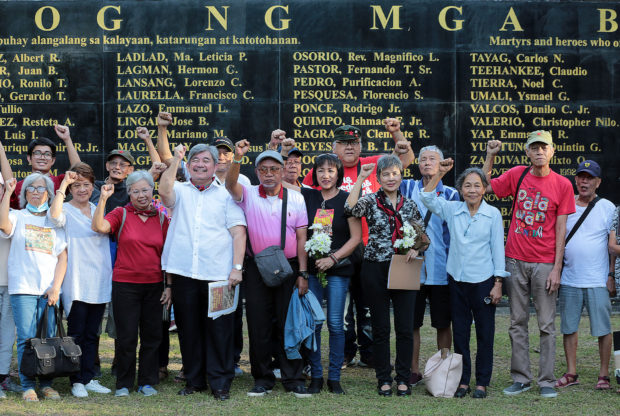FQS veterans mark 50th year of protests

REUNION First Quarter Storm veterans commemorate the 50th anniversary of the student-led protest movement at Bantayog ng mga Bayani in Quezon City on Jan. 26. —GRIG C. MONTEGRANDE
MANILA, Philippines — Fifty years to the day when they lit the fires of student activism in the country, key participants in the First Quarter Storm (FQS) gathered at Bantayog ng mga Bayani in Quezon City on Jan. 26 to rekindle old memories and pay tribute to fallen comrades.
Now grizzled 60- or 70-somethings, they lit candles for martyred friends and recalled the ferocity and courage with which they stormed the gates of Congress on Jan. 26, 1970, and Mendiola Bridge four days later, in that tumultuous prelude to martial law.
But it wasn’t just a time for remembrances for these “young once.”
“This is not just a trip down memory lane. This is not only a reiteration of our determination to keep fighting,” said activist professor and former Social Welfare Secretary Judy Taguiwalo.
Anti-Marcos protests
The purpose of the reunion was threefold, according to the organizers, led by the FQS Movement, SDK (Samahang Demokratiko ng Kabataan) Foundation, and the Bantayog ng mga Bayani Foundation, among other groups.
Article continues after this advertisementFirst was to remember and honor the youth, along with sectarian groups representing women, laborers, farmers, urban poor and professionals, who set up the pillars of the protest movement against the budding tyranny of then President Ferdinand Marcos, who would place the Philippines under martial law and install himself as dictator on Sept. 23, 1972.
Article continues after this advertisementSecond was to recognize the modern-day struggles of the present generation for true democracy and freedom.
And third, to show support for the resumption of peace talks with the communist rebels whose ranks were at the forefront of the FQS event, as well as demand the release of political prisoners.
The gathering featured an exhibit of faded newspaper clippings and memorabilia that recalled the events leading up to the FQS and its aftermath.
An afternoon program saw the FQS veterans singing old battle hymns and listening to an emotional reading of National Artist for Literature Amado V. Hernandez’s poem “Kung Tuyo na ang Luha Mo, Aking Bayan (When Your Tears Run Dry, My Motherland).”
Relatives, friends and comrades of freedom fighters and martial law heroes Rizalina Ilagan, Emmanuel Lacaba, Antonio Zumel, Crispin Beltran, Behn Cervantes, Ma. Lorena Barros and Edgar Jopson spoke of their life and times.
Acclaimed filmmaker and playwright Bonifacio Ilagan spoke about his sister, Rizalina, who was abducted by state agents in July 1977, a year after he himself was released from detention for his role in the activist movement.
Painful chapters
Rizalina and several students and professors working as community organizers in Southern Tagalog, who would come to be known as the “Southern Tagalog 10,” disappeared, “but there was no doubt that they were killed and the women raped,” Ilagan said.
Noted journalist, screenwriter and poet Pete Lacaba, who wrote “Days of Disquiet, Nights of Rage,” a reportage on FQS and subsequent events, recalled how his brother, writer and activist Emmanuel Lacaba, was caught and killed by state forces in March 1976.
“Our mother searched for him … Fortunately, Eman was identified through his moles,” said Lacaba, who was also detained and tortured during martial law.
The family searched and later found Emmanuel’s writings from high school and college and published them posthumously as “Salvaged Poems” in 1986, and “Salvaged Prose” in 1992.
Speaking to the Inquirer, Lacaba said it was important to keep fresh the memory of such painful chapters in the country’s past.
Otherwise, he said, the Marcos family and its ilk would succeed in rewriting history and continue chipping away and changing the narrative of the dictatorship. After all, they had already succeeded in having the late dictator buried at Libingan ng mga Bayani.
“We need to be more consistent in frequently reminding the public about what truly happened in those times… especially the children and millennials,” Lacaba said.
FQS was a student-led protest movement from January to March 1970, marked by intense and often bloody demonstrations against the Marcos administration.
It is generally considered to have begun on Jan. 26, 1970, the opening of the Seventh Congress, when student activists clashed with riot police after Marcos’ State of the Nation Address.
A papier mache crocodile thrown by protesters at Marcos as he was leaving Congress prompted vicious retaliation from the authorities that, in turn, led to follow-up protests, culminating in the bloody Battle of Mendiola on Jan. 30, 1970.
Former activist Ramon Isberto, now public affairs head of PLDT and its subsidiary Smart, recalled how Edgar Jopson, then the president of the moderate National Union of Students of the Philippines, “actually helped set the stage for the First Quarter Storm.”
Revolutionary spark
Jopson, he said, unwittingly ignited the revolutionary spark of FQS because it was his group that secured a rally permit on the day of Marcos’ speech.
“Because of that permit, so many students were able to assemble together,” Isberto said, recounting Jopson’s gradual transition from a pacifist to a radical who would later go underground to join the rebellion.
“What mattered to (Edjop) most was doing the right thing —not who was right,” he added.
“(Edjop) reminds us that regardless of all the dark times, we are all much better because we have known people like (him),” Isberto said.